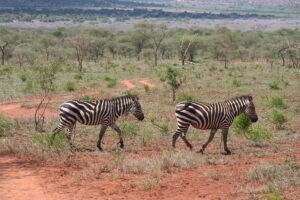Situated in Akagera National Park, the seasonal Karenge Bush camp is also set up two times in the year and removed out, and leaving no trace of its being. Just between this campsite and the lodge is a Karenge and it aims to leave a light footprint on the earth, echoed in the name Karenge that means little foot.
It was named after the river that flows along its eastern boundary and the park has got a diverse land scape as well as fantastic biodiversity. Whether on day or night game drives, you can keep an eye on the eland, topis, giraffes, impalas, sable and roan antelope, zebras, crocodiles, lions, leopards, primates and close 500 bird species. The boat trips on Lake Ihema are also a good opportunity of viewing the water species.

There is a maximum on only 12 visitors that are to be accommodated with in six tents that contain camp beds as well as the beddings, solar lights, camp chairs and the reed matt floors. Each of the tents has got a rural out door bath room with a hot water delivered on a daily basis. Breakfast, lunch and dinner is also included with in the rate and are served in the dinning tent each day. You can enjoy the excitement of staying in a pop up camp that moves around Akagera national park.
The main highlights
- The seasonal pop up camp which shows the different areas of Akagera National Park
- Intentions to leave a light footprint on earth
- The park is not crowded and its often undervalued, home to over 500 species of birds
- The camp only houses a maximum of 12 guests, and this means that guests can enjoy an intimate safari adventure
- The meals are also included in the rate.
The word Karenge also means a “small foot” in Kinyarwanda language. This also supports well with the camp’s goal to be so eco-friendly and leaves as a small environmental foot print as possible. Since it’s a seasonal camp, it’s open for some periods during each year and changes locations each and every time. This camp is constructed with the ecofriendly materials that are all removed when the camp is decomposed at the end of a season. It’s also a very close atmosphere, since the whole camp fits 12 people across the 6 tents.
In the year 2016, this camp was opened from June to August and December to February 2017. Since it was in the northern end of the park, and I doubt you will have the same lakeside view, and it’s so fun. The cost is also $150 per person for the shared tent. As a prudent traveler, I wince at spending even $50 per night on a room, but you can also be happy that all continues to wards the camps conservation efforts. I also recommend this camp for a weekend and it will be so romantic for a couple.
These tents are also raised which reduces the risk of animal entry, and also increases safety. Each of tents has two comfy beds, the couple lamps as well as the standard hotel room usual basics like the towels and the toiletries. One of my bath rooms was about 10 paces from my tent and wasn’t fully surrounded, which was fine by day and a little threatening at night. There was also something liberating about knowing it all hangs out with nature and common sense told me to look into the outside, and in case an animal decided to amble by.


